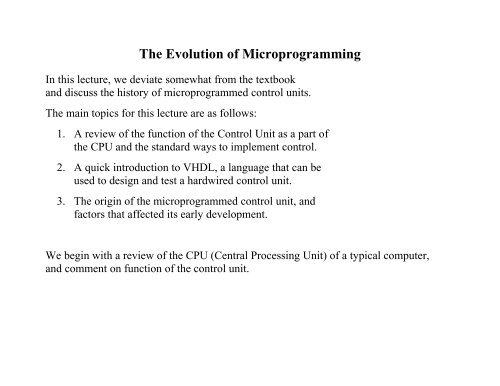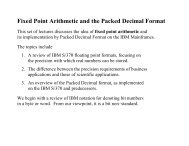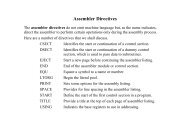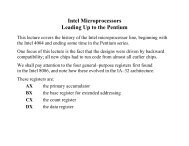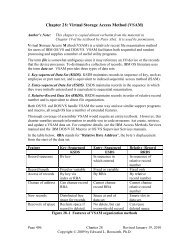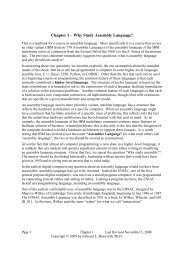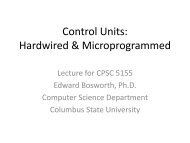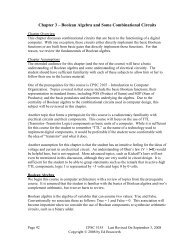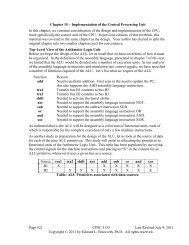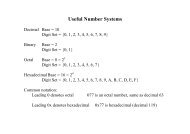Microprogramming: History and Evolution - Edwardbosworth.com
Microprogramming: History and Evolution - Edwardbosworth.com
Microprogramming: History and Evolution - Edwardbosworth.com
Create successful ePaper yourself
Turn your PDF publications into a flip-book with our unique Google optimized e-Paper software.
The <strong>Evolution</strong> of <strong>Microprogramming</strong><br />
In this lecture, we deviate somewhat from the textbook<br />
<strong>and</strong> discuss the history of microprogrammed control units.<br />
The main topics for this lecture are as follows:<br />
1. A review of the function of the Control Unit as a part of<br />
the CPU <strong>and</strong> the st<strong>and</strong>ard ways to implement control.<br />
2. A quick introduction to VHDL, a language that can be<br />
used to design <strong>and</strong> test a hardwired control unit.<br />
3. The origin of the microprogrammed control unit, <strong>and</strong><br />
factors that affected its early development.<br />
We begin with a review of the CPU (Central Processing Unit) of a typical <strong>com</strong>puter,<br />
<strong>and</strong> <strong>com</strong>ment on function of the control unit.
The Central Processing Unit (CPU)<br />
The CPU has four main <strong>com</strong>ponents:<br />
1. The Control Unit (along with the IR) interprets the machine language instruction<br />
<strong>and</strong> issues the control signals to make the CPU execute that instruction.<br />
2. The ALU (Arithmetic Logic Unit) that does the arithmetic <strong>and</strong> logic.<br />
3. The Register Set (Register File) that stores temporary results related to the<br />
<strong>com</strong>putations. There are also Special Purpose Registers used by the Control Unit.<br />
4. An internal bus structure for <strong>com</strong>munication.<br />
The function of the control unit is to decode the binary machine word in the IR<br />
(Instruction Register) <strong>and</strong> issue appropriate control signals, mostly to the CPU. It is the<br />
control signals that cause the <strong>com</strong>puter to execute its program.
Design of the Control Unit<br />
There are two related issues when considering the design of the control unit:<br />
1) the <strong>com</strong>plexity of the Instruction Set Architecture, <strong>and</strong><br />
2) the microarchitecture used to implement the control unit.<br />
In order to make decisions on the <strong>com</strong>plexity, we must place the role of the control unit<br />
within the context of what is called the DSI (Dynamic Static Interface).<br />
The ISA (Instruction Set Architecture) of a <strong>com</strong>puter is the set of assembly language<br />
<strong>com</strong>m<strong>and</strong>s that the <strong>com</strong>puter can execute. It can be seen as the interface between the<br />
software (expressed as assembly language) <strong>and</strong> the hardware.<br />
A more <strong>com</strong>plex ISA requires a more <strong>com</strong>plex control unit.<br />
At some point in the development of <strong>com</strong>puters, the <strong>com</strong>plexity of the control unit<br />
became a problem for the designers. In order to simplify the design, the developers of the<br />
control unit for the IBM–360 elected to make it a microprogrammed unit.<br />
We shall spend some time investigating the motivations of the IBM design team.
The Dynamic–Static Interface<br />
In order to underst<strong>and</strong> the DSI, we must place it within the context of a <strong>com</strong>piler for a<br />
higher–level language. Although most <strong>com</strong>pilers do not emit assembly language, we<br />
shall find it easier to under the DSI if we pretend that they do.<br />
What does the <strong>com</strong>piler output? There are two options:<br />
1. A very simple assembly language. This requires a sophisticated <strong>com</strong>piler.<br />
2. A more <strong>com</strong>plex assembly language. This may allow a simpler <strong>com</strong>piler,<br />
but it requires a more <strong>com</strong>plex control unit. If <strong>com</strong>plex enough, parts of the<br />
control unit are probably microprogrammed.
How Does the Control Unit Work?<br />
The binary form of the instruction is now in the IR (Instruction Register).<br />
The control unit decodes that instruction <strong>and</strong> generates the control signals necessary for<br />
the CPU to act as directed by the machine language instruction.<br />
The two major design categories here are hard–wired <strong>and</strong> microprogrammed.<br />
Hardwired:<br />
The control signals are generated as an output of a<br />
set of basic logic gates, the input of which derives<br />
from the binary bits in the Instruction Register.<br />
Microprogrammed:<br />
The control signals are generated by a microprogram<br />
that is stored in Control Read Only Memory.<br />
The microcontroller fetches a control word from the<br />
CROM <strong>and</strong> places it into the MBR, from which<br />
control signals are emitted.<br />
The microcontroller can almost be seen as a very simple <strong>com</strong>puter within a more<br />
<strong>com</strong>plex <strong>com</strong>puter. This simplicity was part of the original motivation.
The Microprogrammed Control Unit<br />
In a microprogrammed control unit, the control signals correspond to bits in a<br />
micromemory (CROM for Control ROM), which are read into a micro–MBR. This<br />
register is just a set of D flip–flops, the contents of which are emitted as signals.<br />
The micro–control unit ( CU )<br />
1) places an address into the micro–Memory Address Register ( MAR ),<br />
2) the control word is read from the Control Read–Only Memory,<br />
3) puts the microcode word into the micro–Memory Buffer Register, <strong>and</strong><br />
4) the control signals are issued.
Maurice Wilkes<br />
Maurice Wilkes worked in the Computing Laboratory at Cambridge University<br />
beginning in 1936, but mostly from 1945 as he served in WW 2.<br />
He read von Neumann’s preliminary report on the EDVAC in 1946. He immediately<br />
―recognized this as the real thing‖ <strong>and</strong> started on building a stored program <strong>com</strong>puter. In<br />
August 1946 he attended a series of lectures ―Theory <strong>and</strong> Techniques for Design of<br />
Electronic Digital Computers‖ given at the Moore School of Engineering at the<br />
University of Pennsylvania <strong>and</strong> met many of the designers of the ENIAC.<br />
On May 6, 1949 the EDSAC was first operational, <strong>com</strong>puting the values of N 2 for<br />
1 N 99. In 1951, Wilkes published The Preparation of Programs for Electronic<br />
Digital Computers, the first book on programming. I have a 1958 edition.<br />
Also in 1951, Wilkes published a paper ―The Best Way to Design an Automatic<br />
Calculating Machine‖ that described a technique that he microprogramming. This<br />
technique is still in use today <strong>and</strong> still has the same name.<br />
In 1953, Wilkes <strong>and</strong> Stringer further described the technique <strong>and</strong> considered issues of<br />
design <strong>com</strong>plexity, test <strong>and</strong> verification of the control logic, pipelining access to the<br />
control store, <strong>and</strong> support of different ISA (Instruction Set Architectures)<br />
(Wilkes <strong>and</strong> Stringer, 1953).
Wilkes’ Motivations<br />
―As soon as we started programming, we found to our surprise that it wasn’t<br />
as easy to get programs right as we had thought. … I can remember the exact<br />
instant when I realized that a large part of my life from then on was going to<br />
be spent in finding mistakes in my own programs.‖<br />
After his visit to the United States, Wilkes started to worry about the <strong>com</strong>plexity of the<br />
control unit of the EDVAC, then in design. Here is what he wrote later.<br />
“I found that it did indeed have a centralized control based on the use of a matrix<br />
of diodes. It was, however, only capable of producing a fixed sequence of eight<br />
pulses—a different sequence for each instruction, but nevertheless fixed as far as<br />
a particular instruction was concerned. It was not, I think, until I got back to<br />
Cambridge that I realized that the solution was to turn the control unit into a<br />
<strong>com</strong>puter in miniature by adding a second matrix to determine the flow of control<br />
at the microlevel <strong>and</strong> by providing for conditional microinstructions.”<br />
In other words, have the control signals emitted by a smaller <strong>com</strong>puter that is controlled<br />
by a microprogram. The advantage is that the control unit of this smaller <strong>com</strong>puter is<br />
extremely simple to design, test, <strong>and</strong> underst<strong>and</strong>.
A Diode Memory<br />
A diode is a one way current gate. It causes current to flow one way only.<br />
Specifically: For current in one direction, it offers almost no resistance<br />
For current in the opposite direction, it appears as a very large resistance.<br />
A diode memory is just a collection of diodes connected in a matrix.<br />
Follow the current paths. This shows the contents of each word. This is a classic ROM.
Problems in the 1950’s<br />
In 1958, the EDSAC 2 became operational; it was the first microprogrammed <strong>com</strong>puter.<br />
The control unit used ROM made from magnetic cores (Hennessy & Patterson, 1990).<br />
There were two reasons that Wilkes’ idea did not take off in the 1950’s.<br />
1. The simple instruction sets of the time did not dem<strong>and</strong> microprogramming, <strong>and</strong><br />
2. The methods for fabricating a microprogram control store were not adequate.<br />
All of this changed when IBM embraced microprogramming as a method for the<br />
control units of their System/360 design.<br />
We should note that the early control stores for the IBM System/360 were implemented<br />
with technologies that are no obsolete <strong>and</strong> strange to our ears.<br />
BCROS<br />
TROS<br />
CCROS<br />
Balanced Capacitor Read–Only Storage<br />
Two capacitors per word in a storage of 2816 words of 100 bits each.<br />
Transformer Read–Only Storage.<br />
Magnetic core storage of 8192 words of 54 bits each.<br />
Card Capacitor Read–Only Storage.<br />
Mylar cards the size of st<strong>and</strong>ard punch cards with copper tabs.
Early Interest in <strong>Microprogramming</strong><br />
We begin by quoting from the article Readings in <strong>Microprogramming</strong>.<br />
―Microprogram control is seen as a form of simulation in which<br />
primitive operations are <strong>com</strong>bined <strong>and</strong> sequenced so as to imitate<br />
the characteristics of a desired machine.‖<br />
Davies begins his article with a discussion of what then was an important use<br />
of microprogramming – to use one <strong>com</strong>puter to emulate another.<br />
He considers two in<strong>com</strong>patible architectures: the IBM 7040 <strong>and</strong> IBM 7094.<br />
He postulated the following scenario.<br />
1. There is at h<strong>and</strong> an IBM 7094 upon which we want to run a program.<br />
This will be called the host system.<br />
2. There is a large [assembly language] program written for an IBM 7040.<br />
This is called the target system.<br />
The IBM 7094 running IBM 7040 code is called a virtual system.<br />
Source: (Davies, 1972)
<strong>Microprogramming</strong> is Taken Seriously<br />
It was with the introduction of the IBM System/360 that microprogramming was taken<br />
seriously as an option for designing control units. There were three reasons.<br />
1. The recent availability of memory units with sufficient reliability <strong>and</strong><br />
reasonable cost.<br />
2. The fact that IBM took the technology seriously.<br />
3. The fact that IBM aggressively pushed the memory technology inside the<br />
<strong>com</strong>pany to make microprogramming feasible.<br />
IBM’ goals are stated in the 1967 paper by Tucker.<br />
―<strong>Microprogramming</strong> in the System/360 line is not meant to provide the problem<br />
programmer with an instruction set that he can custom–tailor. Quite the<br />
contrary, it has been used to help design a fixed instruction set capable of<br />
reaching across a <strong>com</strong>patible line of machines in a wide range of performances.<br />
… The use of microprogramming has, however, made it feasible for the smaller<br />
models of System/360 to provide the same <strong>com</strong>prehensive instruction set as the<br />
large models.‖<br />
Tucker notes that the use of a ROS [Read Only Store] is somewhat expensive, be<strong>com</strong>ing<br />
attractive only as ―an instruction set be<strong>com</strong>es more <strong>com</strong>prehensive‖.<br />
Source: (Page 225 of Tucker, 1967)
<strong>Microprogramming</strong> is Taken Seriously<br />
(By IBM’s Customers)<br />
The primary intent of the IBM design team was to generate an entire family of <strong>com</strong>puters<br />
with one ISA (Instruction Set Architecture) but many different organizations.<br />
<strong>Microprogramming</strong> allowed <strong>com</strong>puters of a wide range of <strong>com</strong>puting power (<strong>and</strong> cost)<br />
to implement the same instruction set <strong>and</strong> run the same assembly language software.<br />
Several of the IBM product line managers saw another use for microprogramming, one<br />
that their customer base thought to be extremely important: allowing assembly language<br />
programs from earlier models (IBM 1401, IBM 7040, IBM 7094) to run unchanged<br />
on any model of the System/360 series.<br />
As one later author put it, it was only the introduction of microprogramming <strong>and</strong> the<br />
emulation of earlier machines allowed by this feature that prevented ―mass defections‖ of<br />
the IBM customer base to other <strong>com</strong>panies, such as Honeywell, that were certainly<br />
looking for the business.<br />
This idea was proposed <strong>and</strong> named “emulation” by Stewart Tucker (quoted above).
Here I just quote our textbook.<br />
The 1960’s <strong>and</strong> 1970’s<br />
―In the 1960s <strong>and</strong> 1970s, microprogramming was one of the most important<br />
techniques used in implementing machines. Through most of that period,<br />
machines were implemented with discrete <strong>com</strong>ponents or MSI (mediumscale<br />
integration—fewer than 1000 gates per chip), ….[Designers could<br />
choose between a hardwired control unit based on a finite–state–machine<br />
model or a microprogrammed control unit].<br />
The reliance on st<strong>and</strong>ard parts of low- to medium-level integration made these<br />
two design styles radically different. Microprogrammed approaches were<br />
attractive because implementing the control with a large collection of lowdensity<br />
gates was extremely costly. Furthermore, the popularity of relatively<br />
<strong>com</strong>plex instruction sets dem<strong>and</strong>ed a large control unit, making a ROM-based<br />
implementation much more efficient. The hardwired implementations were<br />
faster, but too costly for most machines. Furthermore, it was very difficult to<br />
get the control correct, <strong>and</strong> changing ROMs was easier than replacing a<br />
r<strong>and</strong>om logic control unit. Eventually, microprogrammed control was<br />
implemented in RAM, to allow changes late in the design cycle, <strong>and</strong> even in<br />
the field after a machine shipped.‖
The Microprogram Design Process<br />
Here we make an assertion that is almost true on the face of it: the design <strong>and</strong> testing of a<br />
control unit is one of the more difficult parts of developing a new <strong>com</strong>puter.<br />
In the late 1970’s, microprogramming had be<strong>com</strong>e popular. One of the reasons was the<br />
way in which it facilitated the process of designing the control unit.<br />
<strong>Microprogramming</strong> was quite similar to assembly language programming; many<br />
designers of the time were experts at this.<br />
Microprogram assemblers had been developed <strong>and</strong> were in wide use. The process of<br />
microprogram development was simple:<br />
1. Write the microcode in a symbolic ―microassembly‖<br />
language <strong>and</strong> assemble it into binary microcode.<br />
2. Download the microcode to an EPROM (Erasable<br />
Programmable ROM) using a ROM programmer.<br />
3. Test the microcode, fix the problems, <strong>and</strong> repeat.
The Hardwired Control Unit Design Process<br />
In contrast, prototyping a hardwired control unit took quite a bit of effort. The unit was<br />
built from LSI <strong>and</strong> MSI <strong>com</strong>ponents, wired <strong>and</strong> tested. This was very labor intensive <strong>and</strong><br />
costly, since it most of the work had to be done by degreed engineers.<br />
Recall that in the 1970’s there were few tools to aid hardware design. In particular, there<br />
were no programmable gate arrays to allow quick configuration of hardware <strong>and</strong> no<br />
hardware design languages, such as VHDL, for describing <strong>and</strong> testing a design.<br />
Today, a hardwired control unit is as easy to design <strong>and</strong> test as a microprogrammed unit;<br />
it is first described <strong>and</strong> tested in VHDL.<br />
Source: Page 189 from (Murdocca, 2007)
Benefits of <strong>Microprogramming</strong><br />
As noted above, the primary impediment to adoption of microprogramming was that<br />
sufficiently fast control memory was not readily available.<br />
When the necessary memory became available, microprogramming became popular.<br />
The main advantage of microprogramming was that it h<strong>and</strong>led difficulties associated<br />
with virtual memory, especially those of restarting instructions after page faults.<br />
The IBM System 370 Model 138 implemented virtual memory entirely in microcode<br />
without any hardware support (Hennessy & Patterson, 1990).<br />
Here is a personal memory, dating from the early 1980’s. At that time <strong>com</strong>puters for the<br />
direct execution of the LISP programming language were popular, <strong>and</strong> there were two<br />
major <strong>com</strong>petitors: Symbolics <strong>and</strong> LMI.<br />
At a meeting in Austin, TX, the results of a benchmark <strong>com</strong>petition were announced.<br />
Early in the <strong>com</strong>petition, the LMI – 1 had fared poorly, running at about half of the speed<br />
of the Symbolics –3670. The LMI engineers immediately redesigned the control store<br />
to execute code found in the benchmark. By the <strong>com</strong>petition, the LMI – 1 was officially<br />
a bit faster than the Symbolics – 3670.
The IBM XT/370<br />
IBM was attempting to regain dominance in the desktop market.<br />
They noted that both the S/370 <strong>and</strong> the Motorola 68000 used sixteen 32–bit general<br />
purpose registers.<br />
In 1984 IBM announced the XT/370, a ―370 on a desktop‖, a pair of Motorola 68000s re–<br />
microprogrammed to emulate the S/370 instruction set. Two units were required because<br />
the control store on the Motorola was too small for the S/370.<br />
As a <strong>com</strong>puter the project was successful. It failed because IBM wanted full S/370 prices<br />
for the software to run on the XT/370.<br />
Source: Page 189 from (Murdocca, 2007)<br />
Confirmed on the IBM Web Site (Kozuh, 1984)
Side–Effects of <strong>Microprogramming</strong><br />
It is a simple fact that the introduction of microprogramming allowed the development of<br />
Instruction Set Architectures of almost arbitrary <strong>com</strong>plexity.<br />
The VAX series of <strong>com</strong>puters, marketed by the Digital Equipment Corporation, is usually<br />
seen as the ―high water mark‖ of microprogrammed designs. The later VAX designs<br />
supported an Instruction Set Architecture with more than 300 instructions <strong>and</strong> more than<br />
a dozen addressing modes.<br />
When examining the IA–32 Instruction Set Architecture, we may not a number of<br />
instructions of significant <strong>com</strong>plexity. These were introduced to support high–level<br />
languages (remember the ―semantic gap‖). It was later discovered that these were rarely<br />
used by <strong>com</strong>pilers, but the ―legacy code‖ issue forced their retention.<br />
It is now the case that the existence of these instructions in the IA–32 ISA required that<br />
part of the control unit be microprogrammed; a hardwired control unit would be too<br />
<strong>com</strong>plex. The ghost of the Intel 80286 still haunts us.
VHDL<br />
The VHDL was proposed in the late 1980’s (IEEE St<strong>and</strong>ard 1076–1987) <strong>and</strong> refined in<br />
the 1990’s (IEEE St<strong>and</strong>ards 1164 <strong>and</strong> 1076–1993). The term VHDL st<strong>and</strong>s for<br />
VHSIC (Very High Speed Integrated Circuits) Hardware Description Language.<br />
Here is the VHDL description of a two–input AND gate.<br />
entity AND2 is<br />
port (in1, in2: in std_logic;<br />
out1: out std_logic);<br />
end AND2;<br />
architecture behavioral_2 of AND2 is<br />
begin<br />
end behavioral_2;<br />
out1
<strong>Microprogramming</strong> <strong>and</strong> Memory Technologies<br />
The drawback of microcode has always been memory performance; the CPU<br />
clock cycle is limited by the time to read the memory.<br />
In the 1950’s, microprogramming was impractical for two reasons.<br />
1. The memory available was not reliable, <strong>and</strong><br />
2. The memory available was the same slow core memory as used in<br />
the main memory of the <strong>com</strong>puter.<br />
In the late 1960’s, semiconductor memory (SRAM) became available for the<br />
control store. It was ten times faster than the DRAM used in main memory. It<br />
is this speed difference that opened the way for microcode.<br />
In the late 1970’s, cache memories using the SRAM became popular. At this<br />
point, the CROM lost its speed advantage.<br />
―For these reasons, instruction sets invented since 1985 have not relied on<br />
microcode‖ (Hennessy & Patterson, 1990).
<strong>Microprogramming</strong>: The Late <strong>Evolution</strong><br />
―The Mc2 [microprogramming control] level was the st<strong>and</strong>ard design for practically all<br />
<strong>com</strong>mercial <strong>com</strong>puters until load/store architectures became fashionable in the 1980s‖.<br />
Events that lead to the reduced emphasis on microprogramming include:<br />
1. The availability of VLSI technology, which allowed a number of improvements,<br />
including on–chip cache memory, at reasonable cost.<br />
2. The availability of ASIC (Application Specific Integrated Circuits) <strong>and</strong> FPGA<br />
(Field Programmable Gate Arrays), each of which could be used to create<br />
custom circuits that were easily tested <strong>and</strong> reconfigured.<br />
3. The beginning of the RISC (Reduced Instruction Set Computer) movement, with<br />
its realization that <strong>com</strong>plex instruction sets were not required.<br />
Modern design practice favors a ―mixed control unit‖ with hardwired control for the<br />
simpler (<strong>and</strong> more <strong>com</strong>mon) instructions <strong>and</strong> microcode implementation of the more<br />
<strong>com</strong>plex (mainly legacy code) instructions.<br />
The later versions (80486 <strong>and</strong> following) of the Intel IA–32 architecture provide a good<br />
example of this ―mixed mode‖ control unit. We examine these to close the lecture.<br />
(page 618 of Warford, 2005)
The IA–32 Control Unit<br />
In order to underst<strong>and</strong> the IA–32 control unit, we must first <strong>com</strong>ment on a fact of<br />
instruction execution in the MIPS. Every instruction in the MIPS can be executed in one<br />
pass through the data path. What is meant by that?<br />
In this chapter, we have studied two variants of the MIPS data path.<br />
1. A single–cycle implementation in which every instruction is <strong>com</strong>pletely<br />
executed in one cycle, hence one pass through the data path.<br />
2. A multi–cycle implementation, in which the execution of each instruction is<br />
divided into 3, 4, or 5 phases, with one clock pulse per phase.<br />
Even here, the instructions can be viewed as taking one pass through the data path.<br />
The MIPS was designed as a RISC machine. Part of this design philosophy calls for<br />
efficient execution of instructions; the single pass through the data path is one result.<br />
The IA–32 architecture, with its requirement for support of legacy designs, is one<br />
example of a CISC (Complex Instruction Set Computer). Some instructions can be<br />
executed in 3 or 4 clock cycles, but some require hundreds of clock cycles.<br />
The design challenge for the later IA–32 implementations is how to provide for quick<br />
execution of the simpler instructions without penalizing the more <strong>com</strong>plex ones.
The IA–32 Control Unit (Part 2)<br />
The later implementations of the IA–32 have used a <strong>com</strong>bination of hardwired <strong>and</strong><br />
microprogrammed control in the design of the control units.<br />
The choice of the control method depends on the <strong>com</strong>plexity of the instruction.<br />
The hardwired control unit is used for all instructions that are simple enough to be<br />
executed in a single pass through the datapath. Fortunately, these instructions are<br />
the most <strong>com</strong>mon in most executable code.<br />
Instructions that are too <strong>com</strong>plex to be h<strong>and</strong>led in one pass through the datapath are<br />
passed to the microprogrammed controller.<br />
IA–32 designs beginning with the Pentium 4 have addressed the <strong>com</strong>plexity inherent in<br />
the IA–32 instruction set architecture in an entirely new way, which might be called a<br />
―RISC Core‖. Each 32–bit instruction is mapped into a number of micro–operations.<br />
In the Pentium 4, the micro–operations are stored in a trace cache, which is form of a<br />
Level–1 Instruction Cache (I–Cache). Each instruction is executed from the trace cache.<br />
There are two possibilities, either the micro–operations are passed to the hardwired<br />
control unit, or a routine in the microprogrammed control ROM is called.
References<br />
(Davies, 1972) Readings in microprogramming, P. M. Davies, IBM Systems Journal,<br />
Vol. 11, No.1, pages 16 –40, 1972<br />
(Hennessy & Patterson, 1990) Computer Architecture: A Quantitative Approach,<br />
ISBN 1 – 55860 – 069 – 8, Sections 5.9 & 5.10 (pages 240 – 243).<br />
(Kozuh, 1984) System/370 capability in a desktop <strong>com</strong>puter, F. T. Kozuh, et. al.,<br />
IBM Systems Journal, Volume 23, Number 3, Page 245 (1984).<br />
(Murdocca, 2007) Computer Architecture <strong>and</strong> Organization,<br />
Miles Murdocca <strong>and</strong> Vincent Heuring, John Wiley & Sons, 2007 ISBN 978 – 0 – 471 – 73388 – 1.<br />
(Tucker, 1967) Microprogram control for System/360, S. G. Tucker, IBM Systems Journal,<br />
Vol. 6, No 4. pages 222 – 241 (1967)<br />
(Warford, 2005) Computer Systems, Jones <strong>and</strong> Bartlett, 2005 ISBN 0 – 7637 – 3239 – 7<br />
(Wilkes <strong>and</strong> Stringer, 1953) <strong>Microprogramming</strong> <strong>and</strong> the Design of the Control Circuits in an<br />
Electronic Digital Computer. Proc Cambridge Phil Soc 49:230-238, 1953.<br />
- Reprinted as chapter 11 in: DP Siewiorek, CG Bell, <strong>and</strong> A Newell. Computer Structures:<br />
Principles <strong>and</strong> Examples. New York: McGraw-Hill, 1982, ISBN 0 – 07 – 057302 – 6.<br />
- Also reprinted in: MV Wilkes. The Genesis of <strong>Microprogramming</strong>. Annals Hist. Computing<br />
8n3:116-126, 1986.


